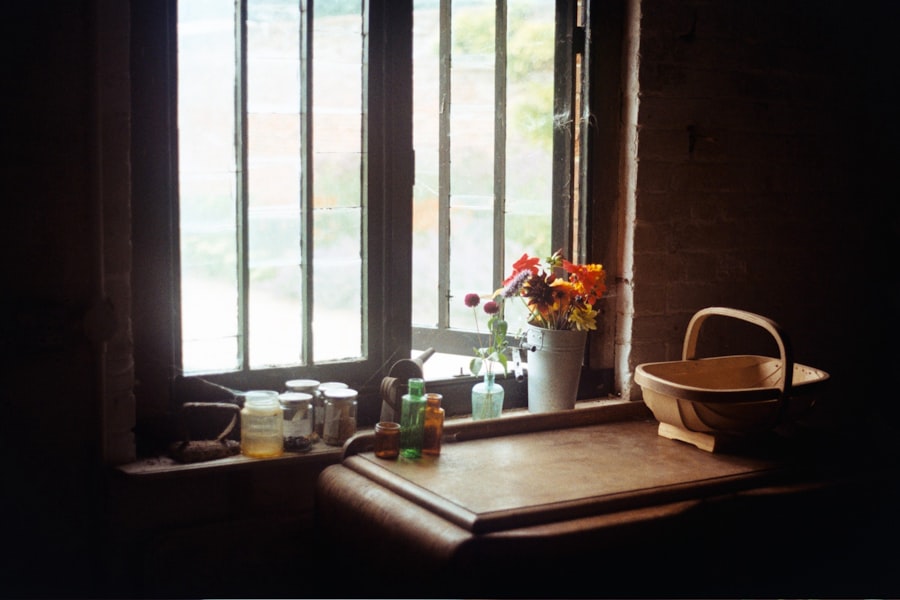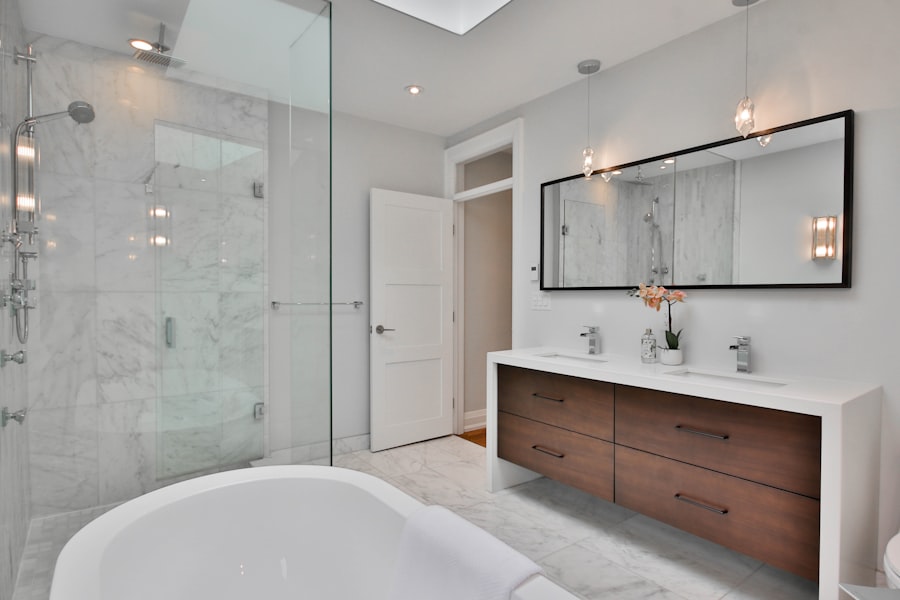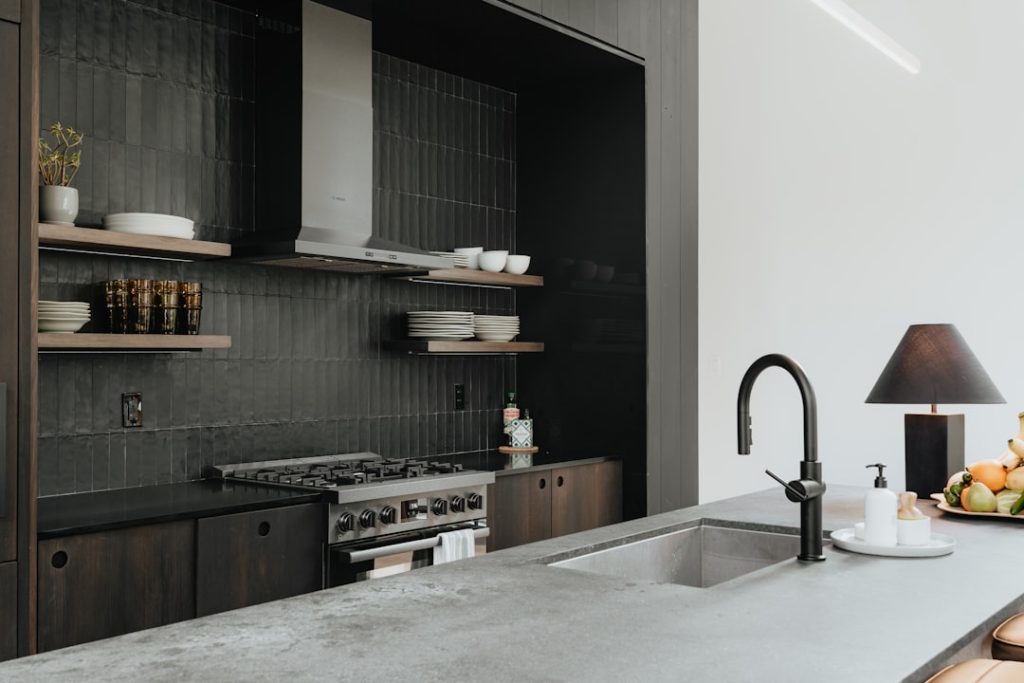Minimalist design has emerged as a dominant trend in contemporary interiors, particularly in kitchens, where functionality and aesthetics converge seamlessly. This design philosophy emphasizes simplicity, clean lines, and a clutter-free environment, allowing the space to breathe and feel more expansive. The essence of minimalism lies in the idea that less is more; by stripping away unnecessary elements, the focus shifts to the quality of materials and the craftsmanship involved.
In a minimalist kitchen, cabinetry often features flat-panel doors without ornate hardware, creating a sleek and unobtrusive look. The color palette typically leans towards neutral tones—whites, grays, and soft earth tones—enhancing the sense of tranquility and order. Incorporating minimalist design into a kitchen also involves thoughtful spatial planning.
Open floor plans are often favored, allowing for a seamless flow between the kitchen and adjacent living areas. This integration not only maximizes space but also fosters social interaction, making the kitchen a central hub for family gatherings and entertaining. Essential appliances are often integrated into cabinetry to maintain a streamlined appearance, while countertops are kept clear of clutter, showcasing only a few carefully selected items.
The result is a kitchen that feels both functional and inviting, where every element serves a purpose and contributes to an overall sense of harmony.
Key Takeaways
- Embrace minimalist design for a clean, clutter-free kitchen aesthetic.
- Use sustainable materials to create eco-friendly and durable kitchen spaces.
- Integrate smart technology for enhanced convenience and efficiency.
- Incorporate open shelving to display items and add visual interest.
- Add statement lighting to highlight key areas and elevate the kitchen’s style.
Sustainable Materials
The growing awareness of environmental issues has led to an increased demand for sustainable materials in kitchen design. Homeowners are now more conscious of the ecological impact of their choices, opting for materials that are not only aesthetically pleasing but also environmentally friendly. Bamboo, for instance, has gained popularity due to its rapid growth and renewability.
It is a durable material that can be used for cabinetry, flooring, and even countertops. Its natural beauty adds warmth to the kitchen while ensuring that the environmental footprint remains minimal. Recycled materials are another excellent choice for sustainable kitchen design.
Reclaimed wood can be transformed into stunning cabinetry or shelving, providing a rustic charm while reducing waste. Similarly, recycled glass countertops offer a unique aesthetic with their vibrant colors and patterns, all while diverting glass from landfills. Additionally, eco-friendly finishes and paints free from volatile organic compounds (VOCs) contribute to healthier indoor air quality.
By choosing sustainable materials, homeowners not only create beautiful kitchens but also contribute to a more sustainable future.
Smart Technology Integration

The integration of smart technology into kitchen design has revolutionized how we interact with our cooking spaces. From smart refrigerators that can track inventory to voice-activated assistants that help with meal preparation, technology is enhancing convenience and efficiency in the kitchen. Smart appliances can be controlled remotely via smartphones or tablets, allowing users to preheat ovens or adjust settings while away from home.
This level of connectivity not only saves time but also adds an element of modernity to the kitchen. Moreover, smart technology can significantly improve energy efficiency. For instance, smart thermostats can optimize heating and cooling based on usage patterns, while energy-efficient appliances reduce electricity consumption without sacrificing performance.
Additionally, smart lighting systems can be programmed to adjust according to the time of day or activity, creating the perfect ambiance for cooking or entertaining. As technology continues to evolve, the possibilities for smart kitchen integration are virtually limitless, making it an essential consideration for modern homeowners.
Open Shelving
| Metric | Description | Typical Value | Unit |
|---|---|---|---|
| Load Capacity | Maximum weight the shelving can hold per shelf | 150-300 | kg per shelf |
| Height | Standard height of open shelving units | 180-240 | cm |
| Width | Standard width of shelving units | 80-120 | cm |
| Depth | Standard depth of shelves | 30-45 | cm |
| Material | Common materials used for open shelving | Wood, Metal, MDF | N/A |
| Adjustable Shelves | Whether shelves can be repositioned | Yes | N/A |
| Ventilation | Airflow characteristic due to open design | High | N/A |
| Accessibility | Ease of access to stored items | Easy | N/A |
| Cost Range | Typical cost range for basic open shelving units | 50-200 | Units (varies by size and material) |
Open shelving has become a popular design choice in kitchens, offering both aesthetic appeal and practical benefits. This trend allows homeowners to display their dishware, cookbooks, and decorative items while keeping them easily accessible. Open shelves create an airy feel in the kitchen, breaking up the visual heaviness of traditional cabinetry and inviting light into the space.
By showcasing personal collections or curated items, open shelving adds character and individuality to the kitchen. However, open shelving does require a certain level of organization and maintenance. Unlike closed cabinets that can hide clutter, open shelves demand careful arrangement to maintain a tidy appearance.
Homeowners often choose to display only their most beautiful or frequently used items, creating a curated look that reflects their style. Additionally, incorporating various materials—such as wood, metal brackets, or glass—can enhance the visual interest of open shelving. When designed thoughtfully, open shelves can serve as both functional storage solutions and striking focal points in the kitchen.
Statement Lighting
Lighting plays a crucial role in kitchen design, not only for functionality but also for setting the mood and enhancing aesthetics. Statement lighting fixtures have emerged as a key trend, serving as eye-catching focal points that elevate the overall design of the space. Pendant lights above an island or dining area can create a dramatic effect while providing essential task lighting.
These fixtures come in various styles—from industrial metal designs to elegant glass globes—allowing homeowners to express their personal taste. In addition to pendant lights, chandeliers have found their way into modern kitchens, adding a touch of sophistication and glamour. A well-placed chandelier can transform an ordinary kitchen into an extraordinary space, making it feel more like an extension of the home rather than just a functional area.
Layering different types of lighting—ambient, task, and accent—ensures that the kitchen is well-lit for various activities while also creating visual depth. By selecting statement lighting that complements the overall design theme, homeowners can achieve a cohesive look that enhances both functionality and style.
Mixed Metals

The trend of mixing metals in kitchen design has gained traction as homeowners seek to create unique and personalized spaces. Gone are the days when matching all fixtures and finishes was considered essential; today’s designs embrace the beauty of contrast and variety. Mixing metals—such as brass, stainless steel, copper, and matte black—can add depth and interest to a kitchen while allowing for greater creative expression.
For example, pairing polished brass cabinet hardware with stainless steel appliances creates a striking juxtaposition that draws the eye. Similarly, incorporating copper accents through light fixtures or cookware can introduce warmth and richness to an otherwise cool-toned space. The key to successfully mixing metals lies in maintaining balance; it’s important to ensure that no single metal dominates the design.
By thoughtfully combining different finishes throughout the kitchen—such as faucets, light fixtures, and cabinet handles—homeowners can achieve a cohesive yet dynamic look that reflects their personal style.
Bold Color Choices
In recent years, bold color choices have made a significant impact on kitchen design, moving away from traditional neutrals towards vibrant hues that make a statement. Homeowners are increasingly willing to experiment with color on cabinetry, backsplashes, and even appliances to create kitchens that are both lively and inviting. Deep blues, rich greens, and striking blacks have become popular choices for cabinetry, offering a dramatic contrast against lighter countertops and walls.
Accent colors can also play a vital role in adding personality to the kitchen. A bright yellow backsplash or vibrant red bar stools can serve as focal points that energize the space without overwhelming it. Additionally, using color strategically can help define different areas within an open-concept layout; for instance, painting an island in a bold hue can visually separate it from surrounding spaces while still maintaining cohesion with the overall design scheme.
By embracing bold color choices, homeowners can transform their kitchens into dynamic environments that reflect their unique tastes.
Spa-like Features
The concept of creating spa-like features in kitchens has gained popularity as homeowners seek to infuse tranquility into their cooking spaces. This trend emphasizes relaxation and comfort through thoughtful design elements that evoke a sense of serenity typically associated with spas. One way to achieve this is by incorporating natural materials such as stone countertops or wooden accents that bring warmth and organic beauty into the kitchen.
Another essential aspect of spa-like kitchens is the integration of calming colors and soft lighting. Soft whites, muted greens, or gentle blues can create a soothing atmosphere that encourages relaxation while cooking or entertaining. Additionally, features such as built-in herb gardens or water filtration systems can enhance the sensory experience by providing fresh ingredients at hand and ensuring clean drinking water is readily available.
Furthermore, incorporating high-quality appliances that offer advanced cooking capabilities can elevate the culinary experience to one akin to gourmet cooking classes found in luxury spas. Induction cooktops provide precise temperature control while being easy to clean; steam ovens allow for healthy cooking methods that preserve nutrients in food; and built-in coffee machines offer barista-quality beverages at home. By integrating these spa-like features into kitchen design, homeowners can create spaces that not only serve practical purposes but also promote well-being and relaxation amidst daily routines.




